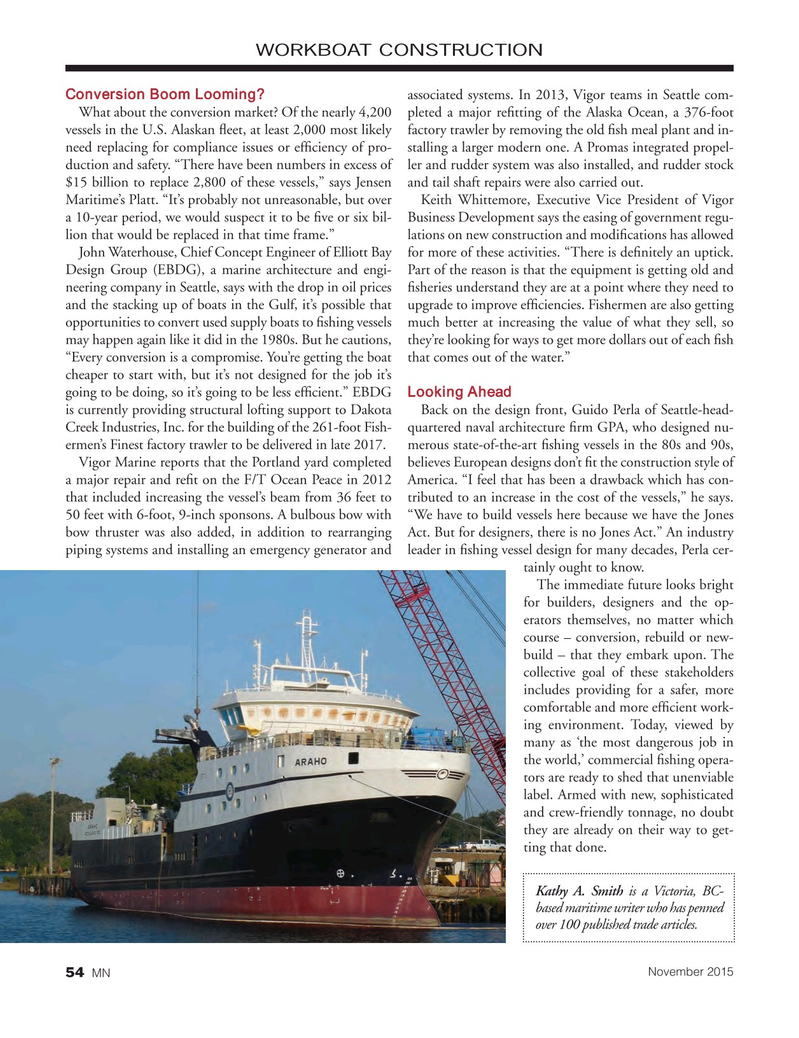
Page 54: of Marine News Magazine (November 2015)
Workboat Annual
Read this page in Pdf, Flash or Html5 edition of November 2015 Marine News Magazine
WORKBOAT CONSTRUCTION
Conversion Boom Looming? associated systems. In 2013, Vigor teams in Seattle com-
What about the conversion market? Of the nearly 4,200 pleted a major re? tting of the Alaska Ocean, a 376-foot vessels in the U.S. Alaskan ? eet, at least 2,000 most likely factory trawler by removing the old ? sh meal plant and in- need replacing for compliance issues or ef? ciency of pro- stalling a larger modern one. A Promas integrated propel- duction and safety. “There have been numbers in excess of ler and rudder system was also installed, and rudder stock $15 billion to replace 2,800 of these vessels,” says Jensen and tail shaft repairs were also carried out.
Maritime’s Platt. “It’s probably not unreasonable, but over Keith Whittemore, Executive Vice President of Vigor a 10-year period, we would suspect it to be ? ve or six bil- Business Development says the easing of government regu- lion that would be replaced in that time frame.” lations on new construction and modi? cations has allowed
John Waterhouse, Chief Concept Engineer of Elliott Bay for more of these activities. “There is de? nitely an uptick.
Design Group (EBDG), a marine architecture and engi- Part of the reason is that the equipment is getting old and neering company in Seattle, says with the drop in oil prices ? sheries understand they are at a point where they need to and the stacking up of boats in the Gulf, it’s possible that upgrade to improve ef? ciencies. Fishermen are also getting opportunities to convert used supply boats to ? shing vessels much better at increasing the value of what they sell, so may happen again like it did in the 1980s. But he cautions, they’re looking for ways to get more dollars out of each ? sh “Every conversion is a compromise. You’re getting the boat that comes out of the water.” cheaper to start with, but it’s not designed for the job it’s going to be doing, so it’s going to be less ef? cient.” EBDG Looking Ahead is currently providing structural lofting support to Dakota Back on the design front, Guido Perla of Seattle-head-
Creek Industries, Inc. for the building of the 261-foot Fish- quartered naval architecture ? rm GPA, who designed nu- ermen’s Finest factory trawler to be delivered in late 2017. merous state-of-the-art ? shing vessels in the 80s and 90s,
Vigor Marine reports that the Portland yard completed believes European designs don’t ? t the construction style of a major repair and re? t on the F/T Ocean Peace in 2012 America. “I feel that has been a drawback which has con- that included increasing the vessel’s beam from 36 feet to tributed to an increase in the cost of the vessels,” he says. 50 feet with 6-foot, 9-inch sponsons. A bulbous bow with “We have to build vessels here because we have the Jones bow thruster was also added, in addition to rearranging Act. But for designers, there is no Jones Act.” An industry piping systems and installing an emergency generator and leader in ? shing vessel design for many decades, Perla cer- tainly ought to know.
The immediate future looks bright for builders, designers and the op- erators themselves, no matter which course – conversion, rebuild or new- build – that they embark upon. The collective goal of these stakeholders includes providing for a safer, more comfortable and more ef? cient work- ing environment. Today, viewed by many as ‘the most dangerous job in the world,’ commercial ? shing opera- tors are ready to shed that unenviable label. Armed with new, sophisticated and crew-friendly tonnage, no doubt they are already on their way to get- ting that done.
Kathy A. Smith is a Victoria, BC- based maritime writer who has penned over 100 published trade articles.
November 2015
MN 54
MN Nov15 Layout 50-65.indd 54 10/23/2015 2:20:29 PM

 53
53

 55
55
